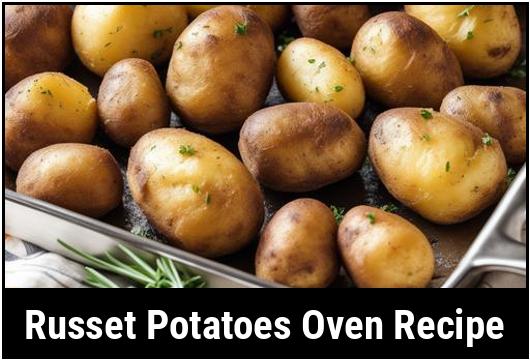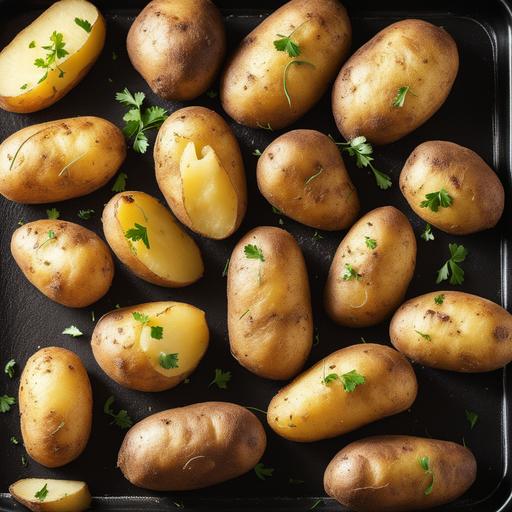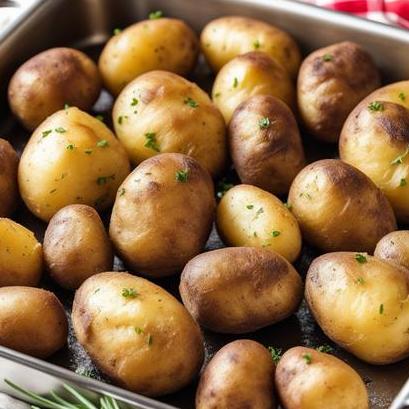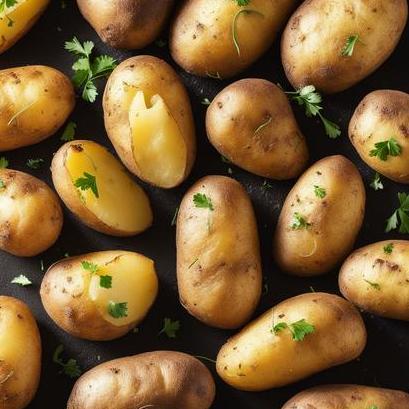
Russet Potatoes Oven Recipe: A Comprehensive Guide
Russet potatoes, with their earthy flavor and fluffy texture, are a versatile ingredient that can be transformed into numerous delectable dishes. One popular method of cooking russet potatoes is in the oven, which yields a crispy exterior and a soft, creamy interior. In this comprehensive guide, we will delve into the food science behind cooking russet potatoes in an oven, explore the factors to consider when choosing ingredients, discuss the preparation techniques, and provide a detailed recipe for oven-baked russet potatoes.
Food Science Of Cooking Russet Potatoes In An Oven
Understanding the science behind cooking russet potatoes in an oven is crucial for achieving the perfect texture and flavor. Russet potatoes, also known as Idaho potatoes, are high in starch and low in moisture compared to other potato varieties. This starch content is what gives russet potatoes their fluffy texture when cooked.
When russet potatoes are baked in an oven, the heat causes the water inside the potato cells to turn into steam. As the steam expands, it creates air pockets, resulting in the characteristic light and fluffy texture of baked potatoes. The high starch content also contributes to the crispy exterior that forms during baking.
However, achieving the ideal texture requires careful control of temperature and timing. Too high a temperature can cause the exterior to brown too quickly while leaving the interior undercooked, whereas too low a temperature can result in a soggy texture.
Choosing Ingredients
Selecting the right ingredients is essential for making delicious oven-baked russet potatoes. When choosing russet potatoes, look for ones that are firm, smooth-skinned, and free of blemishes. Avoid potatoes with green spots or sprouts, as these indicate that the potatoes may be past their prime and can taste bitter.
Additionally, consider the toppings and seasonings you plan to use. Classic toppings for baked potatoes include butter, sour cream, cheese, chives, bacon bits, and cheddar cheese. You can also experiment with different herbs and spices to customize the flavor to your liking.
Preparing Ingredients

Proper preparation of the ingredients is key to achieving the perfect baked potato. Start by scrubbing the russet potatoes under cold running water to remove any dirt or debris from the skin. Pat them dry with a clean kitchen towel.
Next, use a fork to pierce the potatoes several times on all sides. This allows steam to escape during baking, preventing the potatoes from bursting. Optionally, you can rub the potatoes with olive oil and sprinkle them with salt before baking to enhance the flavor and promote a crispy skin.
Optimal Oven Cooking Temperature & Timing
Setting the oven to the correct temperature and timing is crucial for baking russet potatoes to perfection. Preheat the oven to 400°F (200°C) for a balance of crispy skin and fluffy interior. This temperature allows the potatoes to cook evenly without drying out or becoming too soft.
Place the prepared russet potatoes directly on the middle oven rack, with a baking sheet or aluminum foil lined beneath to catch any drips. Bake for approximately 45 to 60 minutes, depending on the size of the potatoes. To test for doneness, insert a fork into the thickest part of the potato; it should slide in easily with little resistance.
Russet Potatoes Oven Recipe
Ingredients
- 4 large russet potatoes
- Olive oil (optional)
- Salt (optional)
- Toppings of your choice (butter, sour cream, cheese, chives, bacon bits, etc.)
Instructions
- Preheat the oven to 400°F (200°C).
- Scrub the russet potatoes under cold running water to remove any dirt. Pat dry with a clean kitchen towel.
- Pierce the potatoes several times on all sides with a fork to allow steam to escape during baking.
- Optionally, rub the potatoes with olive oil and sprinkle them with salt for added flavor.
- Place the potatoes directly on the middle oven rack, with a baking sheet or aluminum foil lined beneath to catch drips.
- Bake for 45 to 60 minutes, depending on the size of the potatoes, until they are tender and easily pierced with a fork.
- Remove the potatoes from the oven and let them cool for a few minutes before handling.
- Slice each potato lengthwise and fluff the insides with a fork.
- Serve hot with your favorite toppings such as butter, sour cream, cheese, chives, bacon bits, or any other toppings of your choice.
Oven-baked russet potatoes are a classic comfort food that is easy to prepare and incredibly versatile. By understanding the food science behind cooking russet potatoes in an oven, choosing high-quality ingredients, and following the proper preparation and cooking techniques, you can create perfect baked potatoes every time. Whether enjoyed as a simple side dish or dressed up with an array of toppings, oven-baked russet potatoes are sure to be a hit at any meal.
Doneness Checks

Baking russet potatoes in the oven is a simple yet satisfying culinary endeavor. The process involves scrubbing the potatoes, seasoning them, and then baking them until they are tender on the inside and crispy on the outside. Russet potatoes, also known as Idaho potatoes, are ideal for baking due to their high starch content and thick skin, which crisps up beautifully in the oven.
Before diving into the recipe, it’s essential to select the right potatoes. Look for russet potatoes that are firm and free of any blemishes or sprouts. It’s also crucial to choose potatoes that are roughly the same size to ensure even cooking.
Determining when russet potatoes are perfectly cooked can be tricky, but there are several reliable methods to ensure they are done to perfection:
1. Fork Test
The most common method to check for doneness is the fork test. Simply insert a fork into the center of the potato. If it slides in easily with little resistance, the potato is cooked through. If there’s resistance, it needs more time in the oven.
2. Squeeze Test
Another method is the squeeze test. Gently squeeze the potato (using an oven mitt or kitchen towel to protect your hands from the heat). A properly cooked potato should give slightly when squeezed but still feel firm.
3. Internal Temperature
For those who prefer a more precise method, use a kitchen thermometer to check the internal temperature of the potato. It should register between 205°F to 210°F (96°C to 99°C) when fully cooked.
4. Visual Inspection
Lastly, visually inspect the potatoes. They should have a golden brown exterior and appear slightly wrinkled. The skin should be crispy, and a small amount of salt may be visible on the surface.
Undercooking
Undercooking russet potatoes can result in a disappointing dining experience, as they will be too firm and starchy. Here are some common reasons why russet potatoes might be undercooked:
1. Insufficient Baking Time
If the potatoes are removed from the oven too soon, they will not have enough time to cook through. Ensure they are baked for the full duration specified in the recipe or until they pass the doneness tests.
2. Inconsistent Size
Potatoes that vary greatly in size will cook unevenly. Try to select potatoes that are similar in size to promote even cooking.
3. Improper Oven Temperature
An oven that is not properly calibrated can lead to undercooking. Use an oven thermometer to verify that the temperature is accurate.
4. Crowded Oven
Crowding the oven with too many potatoes can impede airflow and prevent even cooking. Leave enough space between the potatoes for hot air to circulate freely.
Overcooking
On the flip side, overcooking russet potatoes can result in a mushy texture and burnt skin. Here’s how to avoid overcooking:
1. Monitoring Time Carefully
Keep a close eye on the potatoes towards the end of the baking time to prevent them from overcooking. Remove them from the oven as soon as they are done.
2. Avoiding High Temperatures
Baking potatoes at excessively high temperatures can cause the skin to burn before the interior is fully cooked. Stick to the recommended oven temperature for best results.
3. Not Leaving Potatoes Unattended
Leaving potatoes in the oven for too long without checking on them can lead to overcooking. Set a timer and periodically check the potatoes for doneness.
4. Storing Potatoes Properly
If potatoes are left in the oven after they are done cooking, they will continue to cook from residual heat and may become overdone. Remove them from the oven promptly and serve immediately.
Troubleshooting

Encountering issues while baking russet potatoes is not uncommon, but most problems can be easily resolved with a few adjustments. Here are some common troubleshooting tips:
1. Burnt Skin
If the potato skins are burning before the interior is fully cooked, reduce the oven temperature and cover the potatoes loosely with aluminum foil to prevent further browning.
2. Raw Interior
If the potatoes are undercooked, return them to the oven and continue baking until they are done. To expedite the cooking process, you can microwave them for a few minutes before returning them to the oven.
3. Tough Skin
Tough potato skins can be caused by inadequate seasoning or improper cooking temperature. Make sure to season the potatoes generously with salt and oil before baking, and bake them at the recommended temperature for crispy skin.
4. Soggy Texture
Soggy potatoes are often the result of overcooking or insufficient draining after washing. To salvage soggy potatoes, blot them with paper towels to remove excess moisture and return them to the oven at a lower temperature to crisp up.
Recipe Variations
While classic baked russet potatoes are delicious on their own, there are countless variations to suit every taste preference. Here are some creative recipe variations to try:
1. Loaded Baked Potatoes
Top baked potatoes with your favorite toppings, such as sour cream, shredded cheese, bacon bits, chives, and diced tomatoes, for a hearty and indulgent meal.
2. Garlic Parmesan Potatoes
Mix minced garlic, grated Parmesan cheese, and chopped fresh parsley with melted butter. Brush the mixture onto the baked potatoes during the last few minutes of cooking for a flavorful twist.
3. Taco Stuffed Potatoes
Fill baked potatoes with seasoned ground beef or turkey, black beans, corn, diced bell peppers, and shredded cheese for a Tex-Mex inspired dish. Serve with salsa, guacamole, and sour cream on the side.
4. Herbed Roasted Potatoes
Toss cubed russet potatoes with olive oil, minced garlic, chopped fresh rosemary, thyme, and oregano. Roast in the oven until crispy and golden brown for a fragrant and savory side dish.
Baking russet potatoes in the oven is a simple yet versatile cooking method that yields delicious results every time. Whether enjoyed as a side dish or dressed up with creative toppings for a main course, baked potatoes are a comforting and satisfying meal option. By following the tips and variations outlined in this guide, you’ll be well-equipped to master the art of baking russet potatoes to perfection. So fire up your oven, gather your ingredients, and enjoy the irresistible aroma of freshly baked potatoes filling your kitchen.
Flavour Enhancement Tips
Baking russet potatoes in the oven is a simple yet rewarding cooking method that brings out the natural flavors of the potatoes while creating a crispy exterior and a tender interior. This method requires minimal preparation and allows for customization with various seasonings and toppings.
Russet potatoes, also known as Idaho potatoes, are large, starchy potatoes with a rough, brown skin and white flesh. They are ideal for baking due to their high starch content, which helps them develop a light and fluffy texture when cooked.
Before diving into the recipe, it’s essential to select high-quality russet potatoes. Look for potatoes that are firm, with smooth skins and no visible bruises or sprouts. Additionally, choose potatoes of similar size to ensure even cooking.
While russet potatoes have a delicious natural flavor on their own, there are several ways to enhance their taste when baking them in the oven:
-
Seasoning: Before baking, coat the potatoes with olive oil and sprinkle them with salt and pepper. You can also add additional seasonings such as garlic powder, onion powder, paprika, or dried herbs like rosemary or thyme for extra flavor.
-
Garlic and Herb Butter: Create a flavorful garlic and herb butter by mixing melted butter with minced garlic and chopped fresh herbs such as parsley, thyme, or chives. Brush this mixture onto the potatoes before baking to infuse them with rich, aromatic flavors.
-
Cheese: For a cheesy twist, sprinkle grated Parmesan or cheddar cheese over the potatoes during the last few minutes of baking. The cheese will melt and form a delicious golden crust on top of the potatoes.
-
Bacon: Crumble cooked bacon over the baked potatoes before serving for a savory, indulgent touch. The smoky flavor of the bacon pairs perfectly with the creamy potatoes.
-
Sour Cream and Chives: Serve the baked potatoes with a dollop of sour cream and a sprinkle of chopped fresh chives for a classic and refreshing topping that complements the potatoes’ richness.
Texture Enhancement Tips

Achieving the perfect texture is key to a successful baked potato. Follow these tips to ensure your russet potatoes turn out light, fluffy, and delicious:
-
Piercing: Before baking, use a fork to pierce the potatoes several times all over. This allows steam to escape during cooking, preventing the potatoes from bursting open and ensuring even cooking.
-
Oil Rub: Rubbing the potatoes with olive oil before baking helps to crisp up the skin and seal in moisture, resulting in a tender interior. Make sure to coat the potatoes evenly for uniform cooking.
-
Baking Method: For the fluffiest texture, bake the potatoes directly on the oven rack rather than on a baking sheet. This allows for better air circulation around the potatoes, resulting in a more evenly cooked interior.
-
Fork Test: To check for doneness, insert a fork into the center of a potato. If it slides in easily with little resistance, the potato is cooked through. Avoid overcooking, as this can lead to a mushy texture.
-
Resting Time: Allow the baked potatoes to rest for a few minutes after removing them from the oven. This allows the steam inside the potatoes to redistribute, resulting in a more uniform texture.
Cooking At Different Temperatures
The cooking temperature plays a crucial role in the texture and flavor of baked russet potatoes. Here are some temperature options to consider:
-
High Heat (400°F – 425°F / 200°C – 220°C): Baking potatoes at a higher temperature results in a crispy skin and a fluffy interior. This method is quicker and ideal for when you’re short on time.
-
Moderate Heat (350°F – 375°F / 175°C – 190°C): Baking potatoes at a moderate temperature yields a slightly softer skin and a creamier interior. This method allows for more gentle cooking, resulting in evenly cooked potatoes.
-
Low Heat (300°F – 325°F / 150°C – 160°C): Baking potatoes at a lower temperature produces a tender skin and an ultra-creamy interior. This method is slower but ensures that the potatoes are cooked evenly without any risk of burning.
Experiment with different temperatures to find the perfect balance of crispiness and tenderness that suits your preferences.
Cooking Tips
Follow these additional tips to ensure success when baking russet potatoes in the oven:
-
Even Size: Choose russet potatoes that are similar in size to ensure even cooking. If using potatoes of different sizes, adjust the cooking time accordingly to prevent smaller potatoes from overcooking or larger ones from undercooking.
-
Uniform Piercing: Use a fork to pierce the potatoes evenly on all sides to allow steam to escape during baking. This prevents the potatoes from exploding in the oven and ensures that they cook evenly.
-
Rotate Potatoes: Halfway through the cooking time, rotate the potatoes to ensure that they bake evenly on all sides. This helps prevent uneven browning and ensures that each potato is cooked to perfection.
-
Check for Doneness: Test the potatoes for doneness by inserting a fork into the center. If it goes in easily with little resistance, the potatoes are ready. Avoid overcooking, as this can result in a mushy texture.
-
Resting Time: Allow the baked potatoes to rest for a few minutes before serving. This allows the steam inside the potatoes to redistribute, resulting in a more uniform texture and easier handling.
Serving Suggestions
Once your russet potatoes are baked to perfection, it’s time to get creative with serving suggestions. Here are some ideas to inspire you:
-
Loaded Baked Potatoes: Split the baked potatoes open and fluff up the insides with a fork. Top them with your favorite toppings such as sour cream, cheddar cheese, bacon bits, chives, and diced green onions for a hearty and indulgent meal.
-
Potato Skins: Scoop out the flesh of baked potatoes, leaving a thin layer attached to the skin. Fill the potato skins with cheese, bacon, and any other toppings of your choice, then bake them for a few more minutes until the cheese is melted and bubbly.
-
Potato Wedges: Cut baked potatoes into wedges and toss them with olive oil, salt, and your favorite seasonings. Bake them for an additional 10-15 minutes until crispy and golden brown, then serve them as a delicious side dish or snack.
-
Potato Salad: Chop baked potatoes into bite-sized pieces and toss them with mayonnaise, mustard, diced celery, red onion, and fresh herbs to make a classic potato salad. Serve it chilled as a refreshing side dish at picnics or barbecues.
-
Mashed Potatoes: Scoop out the flesh of baked potatoes and mash it with butter, milk, salt, and pepper until smooth and creamy. Serve the mashed potatoes as a comforting side dish alongside roasted meats or grilled vegetables.
Conclusion
Baking russet potatoes in the oven is a simple and satisfying way to enjoy this versatile vegetable. By following the tips and techniques outlined in this article, you can achieve perfectly baked potatoes with crispy skins and fluffy interiors every time. Whether you prefer them loaded with toppings, turned into potato skins, or mashed to creamy perfection, baked russet potatoes are sure to be a crowd-pleaser at any meal. Experiment with different seasonings, toppings, and serving ideas to create your own delicious variations and make russet potatoes a staple in your kitchen repertoire.
FAQS
Are Russet Potatoes The Best Type Of Potato For Oven Recipes?
Russet potatoes are excellent for oven recipes due to their high starch content. This gives them a fluffy and light texture when baked, making them perfect for dishes like baked potatoes or potato wedges.
How Should I Prepare Russet Potatoes Before Cooking Them In The Oven?
Before baking, wash the potatoes thoroughly under running water to remove any dirt or debris. For a crispy skin, pat them dry with a clean towel. Pricking the potatoes with a fork or knife a few times allows steam to escape and prevents them from bursting in the oven.
Should I Peel Russet Potatoes Before Cooking Them In The Oven?
Whether to peel the potatoes or not is a matter of personal preference. The skin of russet potatoes becomes crispy and delicious when baked, so it can be left on for added texture and flavor. However, if you prefer a softer and smoother texture, peeling them is recommended.
What Are Some Popular Seasonings Or Toppings For Russet Potatoes Cooked In The Oven?
Russet potatoes can be seasoned with a variety of herbs and spices before baking, such as garlic powder, paprika, dried thyme, or rosemary. Additionally, toppings like shredded cheese, sour cream, chives, or crispy bacon bits can be added after baking for extra flavor.
What Is The Recommended Cooking Time And Temperature For Russet Potatoes In The Oven?
For perfectly cooked russet potatoes, preheat the oven to 425°F (200°C). Place the potatoes directly on the oven rack or on a baking sheet lined with parchment paper. Small to medium-sized potatoes usually take about 45-60 minutes to bake, while larger ones may take longer, around 60-75 minutes. To test their doneness, insert a fork or knife into the center of the potato – it should easily slide through without resistance.


